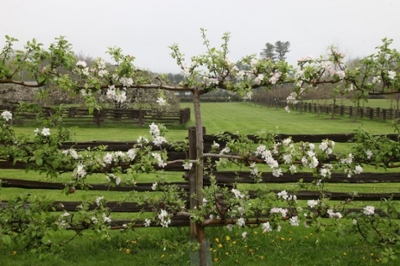 Gardens are rooms – living spaces like their indoor counterparts, except the heating and air conditioning are at the whim of Mother Nature. Like interior rooms, they have walls and doorways, or rather fences and gates.
Gardens are rooms – living spaces like their indoor counterparts, except the heating and air conditioning are at the whim of Mother Nature. Like interior rooms, they have walls and doorways, or rather fences and gates.
Fences and gates not only define the space, but in an urban setting provide security and privacy as they deter theft and help screen neighbors. Those practical aspects of fencing often lead gardeners to forget their aesthetic potential. Allow garden walls to enhance your garden's charm, not simply enclose it.
The edges surrounding a garden can be soft (hedges or mixed planting beds) or hard (wood, metal fences or masonry walls), which create a frame establishing the garden setting. Both are effective in providing a sense of enclosure to the garden room but contribute to the garden's personality in different ways.
Keep in mind your garden's character and the garden wall's purpose when selecting materials. Ornate wrought-iron makes a refined border for a formal garden but may be out of place in a casual garden. If privacy is your goal, a wrought-iron fence won't achieve it unless you supplement it with plantings of vines or hedges. The downside to this approach is you pay a premium price for wrought-iron fencing and then spend more money covering it up.
Utility panel or open picket fences lend themselves to an air of informality. Some believe open fences are less secure; however, they offer visibility into an area, which can be a security plus. They allow airflow into the garden, thwarting mosquitos, whose flying skills are no match for a gentle breeze. If privacy is your primary goal, a combination of solid fencing topped with wooden lattice or metal panels may offer a suitable compromise.
Openings in fences and hedges become doors into the garden room. Gates signal to visitors a movement from public to private space and suggest the character of the garden beyond. Any opening in the garden wall can act as a gate, whether there is a physical gate or not, leading the visitor into a different space.
Detail around the gate emphasizes its importance. For example, a combination of materials, additional trim or color, or alternate patterns not appearing in other fence sections can signal the main entry to and from the garden. If you are fencing off a service yard, a simple wooden gate would be appropriate and inconspicuous.
Walking through a gate slows one's movement. This allows the visitor time to pause and notice the garden features around them. The sound of water from a fountain, the fragrance of a climbing rose, or the time on a sundial are readily enjoyed by this slower pace. Give more detail to those elements near the gate where guests will have time to appreciate them.
Additional openings in fences and hedges create windows into the garden, allowing sneak peeks in and out of the garden. Like windows in the house extend the view into the garden and enlarge the room, windows in the garden wall claim space outside it. Japanese gardeners call this shakkei - borrowed landscape. Openings can be simple voids or filled with wood or metal filigree. Windows allow air movement and visibility for security.
Once you've built the garden room walls, it's time to "paint" them. Walls of a garden provide an opportunity for vertical gardening with espaliers and vines. How you apply them depends on the character of your garden - formal, informal, edible, ornamental or mixed.
Espaliers are shrubs or trees trained to grow flat against the wall. The branches can create a formal pattern or be freeform. Any shrub or tree can be trained in this manner as long as you start with a small plant, a 5-gallon-size container at the largest. While espaliers require training, they open up options for using trees and shrubs you may not have room for otherwise. To learn more about incorporating fruit trees into your landscape, you might think about attending the Urban Harvest The Edible Landscape, Oct. 17.
Vines require a lot less training in the beginning but are aggressive in nature. Once they have established themselves, be prepared to keep them in check. Trellises are needed to support most vines. Ornamental wood or metal trellises create formal patterns and serve in part as garden ornaments. However, vines can be allowed to freely climb a simple trellis crafted from vinyl-coated cable laced through eyehooks and secured with U-clamps.
Fences, gates and windows can be garden assets when given careful consideration. Discard the notion their only purpose is to confine the household pet.
This article is provided by Urban Harvest, Inc. To learn about gardening classes, farmers markets, school and community gardens and more go to www.urbanharvest.org or call 713-880-5540 for more information. This article was written by Suzy Fischer is a registered Landscape Architect and principal of Fischer Schalles, a landscape design/build firm.